F
Former member 60103
Guest
Sunday 24th September 2018. Ruta de La Lana, north of Palazuelos, a coin hot under the midday sun on a sandy farm track. It caught my eye, dull bronze against light sand, regular outline against irregular stone.
This though was not a coin but a button. A cursory visual scan revealed three figures and some writing, too small too make out fully. However later inspection revealed a central female holding a baby atop a pillar with two kneeling characters either side holding staves with what appeared to be gourds on top. The words “ N S DEL PILAR” spaced around the uppermost edge.
Research revealed that this was shorthand for “Nuestra Senora del Pilar” or “Our Lady of the Pillar”. And a story emerged, it could be entitled “St James – the prequel” because it turn's out to be the pilot episode for the St James and Santiago Compostela story that is familiar to us. And I was to learn something because you can teach an old pilgrim new tricks.
The button showed the Virgin Mary holding baby Jesus whilst standing on a pillar. Either side of her are two kneeling pilgrims holding the traditional staff with gourd.
This button probably dates back to around 1800 – 1820 maybe later but certainly well south of 1900.
It indirectly alludes to an appearance before the apostle James by the River Ebro at Zaragoza of the Virgin Mary standing on a pillar flanked by choirs of angels. “Sustained and inspired by this miracle, James erected round the pillar the first church ever to be dedicated to the virgin, and shortly afterwards returned to Jerusalem where he was beheaded by a Roman sword in about the year AD 44*”
From Jerusalem what remained of St. James body (and head) was taken by ship across the Mediterranean into the Atlantic and up to the Bay of Padron to then be taken then to the cave/tomb around which a town later established – “Campo de la Estella – the field of the star – later shortened to Compostela* “
A button less than a centimetre in diameter revealed a story that stretched from Jerusalem to Santiago Compostela. Far from overlooking Zaragoza in my understanding of St James and the Camino I had not even registered it prior to finding that button. I sought to rectify that in March 2020 intending to walk from the Ebro estuary along the Camino Ebro as far as Zaragoza to visit the cathedral built around the church established by St James. Pilgrim Don Camillo intended to pay his respects. But I guess we all know what happened that month and my plans like everyone else's were put on hold.
Still are.
Don.
*Source. The Pilgrimage to Santiago. Edwin Mullins. Secker and Warburg 1974.
This though was not a coin but a button. A cursory visual scan revealed three figures and some writing, too small too make out fully. However later inspection revealed a central female holding a baby atop a pillar with two kneeling characters either side holding staves with what appeared to be gourds on top. The words “ N S DEL PILAR” spaced around the uppermost edge.
Research revealed that this was shorthand for “Nuestra Senora del Pilar” or “Our Lady of the Pillar”. And a story emerged, it could be entitled “St James – the prequel” because it turn's out to be the pilot episode for the St James and Santiago Compostela story that is familiar to us. And I was to learn something because you can teach an old pilgrim new tricks.
The button showed the Virgin Mary holding baby Jesus whilst standing on a pillar. Either side of her are two kneeling pilgrims holding the traditional staff with gourd.
This button probably dates back to around 1800 – 1820 maybe later but certainly well south of 1900.
It indirectly alludes to an appearance before the apostle James by the River Ebro at Zaragoza of the Virgin Mary standing on a pillar flanked by choirs of angels. “Sustained and inspired by this miracle, James erected round the pillar the first church ever to be dedicated to the virgin, and shortly afterwards returned to Jerusalem where he was beheaded by a Roman sword in about the year AD 44*”
From Jerusalem what remained of St. James body (and head) was taken by ship across the Mediterranean into the Atlantic and up to the Bay of Padron to then be taken then to the cave/tomb around which a town later established – “Campo de la Estella – the field of the star – later shortened to Compostela* “
A button less than a centimetre in diameter revealed a story that stretched from Jerusalem to Santiago Compostela. Far from overlooking Zaragoza in my understanding of St James and the Camino I had not even registered it prior to finding that button. I sought to rectify that in March 2020 intending to walk from the Ebro estuary along the Camino Ebro as far as Zaragoza to visit the cathedral built around the church established by St James. Pilgrim Don Camillo intended to pay his respects. But I guess we all know what happened that month and my plans like everyone else's were put on hold.
Still are.
Don.
*Source. The Pilgrimage to Santiago. Edwin Mullins. Secker and Warburg 1974.



















